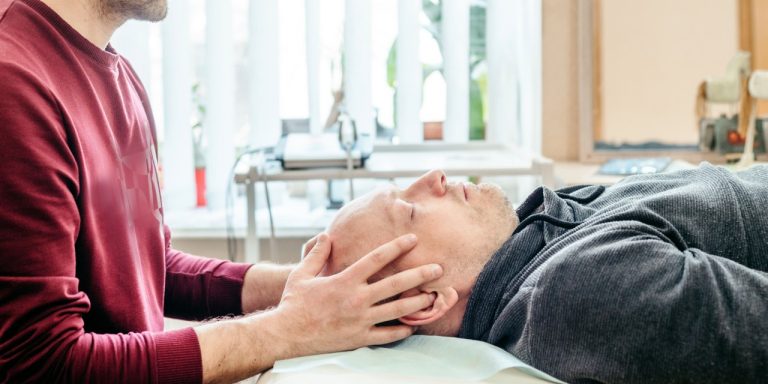Craniosacral therapy: what is it suitable for?
Craniosacral therapy is a method related to osteopathy. What are the costs involved and what is the actual benefit of craniosacral therapy? You can find out all about the side effects and this treatment here.

What is craniosacral therapy?
Craniosacral therapy as we know it today was created from osteopathy in the 1970s by John E. Upledger, before developing into a standalone method of complementary medicine. This form of therapy is based on the notion that the body has its own rhythm called the craniosacral rhythm. This rhythm results from the movement of the cerebrospinal fluid, which pulsates between the skull (cranium) and the sacrum. The craniosacral rhythm is passed on to the entire body and is believed to be beneficial for human development and performance.
Craniosacral therapists detect this rhythm with their hands and give gentle stimuli to encourage rhythmic movement and release blockages. The therapy aims to stimulate the body’s self-healing powers and restore its balance. This approach makes craniosacral therapy suitable for people of all ages as a complementary treatment for various complaints.
Craniosacral therapy: what costs are involved?
Craniosacral therapy is a form of complementary medicine. The costs are governed by how long the treatment lasts. The amount of time required for craniosacral therapy varies depending on why you need treatment.
Does health insurance cover craniosacral therapy?
Basic insurance does not cover craniosacral therapy. Depending on what insurance coverage you have, Helsana will pay a large proportion of the costs. With our COMPLETA supplementary insurance products, you will, for example, receive 75% of the cost of craniosacral therapy performed by a therapist from our list of recognised therapists.
Are you already insured with us and looking for a therapist?
What is the difference between osteopathy and craniosacral therapy?
Osteopathy and craniosacral therapy share common roots and help your body to regulate itself. Osteopaths deal with your entire musculoskeletal system, including your muscles, tendons, ligaments and organs. An osteopath uses touch to sense tension and restricted movement and uses different techniques to mobilise the affected joints and muscles.
During craniosacral therapy, therapists focus specifically on the craniosacral rhythm – the body’s own rhythmic pulse of the fluid between the skull and sacrum. These rhythmical movements provide information about the state of your body and which structures within it have changed. Using gentle hand movements, the craniosacral therapist attempts to restore the normal flow of cerebrospinal fluid and, in doing so, correct functional disorders in your nervous system, tissue, organs, muscles and bones.
Craniosacral therapy: what does it treat?
This form of therapy is used for a variety of complaints and problems. Typical problems treated by craniosacral therapy include:
Stress and tension
Craniosacral therapy can help with stress by have a calming effect on your nervous system. This encourages you to relax. By touching the head and back, the techniques can release physical and emotional tension.
Headaches and migraines
Treatment for headaches or migraines focuses on tension in the neck and head areas. The therapist’s hand movements can improve fluid circulation and therefore reduce the frequency and intensity of headaches.
Tinnitus
Craniosacral therapy is also used to treat tinnitus. The therapist uses techniques that relax the muscles around the ear. This type of stimulation can lessen the intensity of the ringing in the ears.
Back pain
The therapy eases back pain by relieving tension in the spine and surrounding tissue. This can be used for acute and chronic back pain and can help improve mobility.
Chronic pain
If you suffer from chronic pain, craniosacral therapy aims to restore balance in your body. Removing blockages in the connective tissue can alleviate pain and improve general well-being.
Pregnancy
Craniosacral therapy can help your body to adapt during pregnancy and relieve pregnancy-related complaints. The therapist stimulates certain areas of the body depending on what type of discomfort you have.
Sleep disorders
The therapy has a soothing effect on your nervous system, which improves sleep. The relaxing effect on your body and mind can help you fall asleep and improve the quality of your sleep.
Depression
Craniosacral therapy also helps with depression. Its relaxing effect on the nervous system reduces stress – often experienced by people in depressive states.
Can craniosacral therapy help children?
The subtle methods used in craniosacral therapy also make it suitable for children:
- Gentle treatment:
The gentle techniques used are also appropriate for children.
- Calming the nervous system for children with sleep problems:
This therapy can be particularly useful for restless children. The light touches used help the child to relax and feel comfortable. This reduces stress and improves sleep quality.
- Support for learning and concentration difficulties:
Relaxing the nervous system often also has a positive effect on concentration and the ability to learn.
When applied holistically, craniosacral therapy can therefore be beneficial in many situations – even for babies.
Does craniosacral therapy have any side effects?
People respond to craniosacral therapy in different ways. The ideal scenario is that you will simply gain a feeling of well-being after the treatment. However, the treatment does activate several physical processes. You may not feel these, but they can occur as side effects:
- Fatigue: you may feel tired following the craniosacral therapy. This is a sign that your body is relaxed rather than stressed.
- Initial worsening: it is possible that your body will initially respond by temporarily getting worse and you will notice that your symptoms intensify. Like any manual treatment, craniosacral therapy stimulates the body’s system – without this stimulation, our body would not receive any signals to heal itself. It needs a few days to do this. In some cases, the body has first had to compensate for years of dysfunction.
- Pain: you might feel pain after having craniosacral therapy, for example due to the fact that the treatment stimulates blood circulation which temporarily increases tension.
This type of initial deterioration should not last longer than five days. After that, things should greatly improve and the therapy should take effect. If the symptoms do not subside, then you are not experiencing a typical initial worsening phase, and you should get your symptoms investigated. This also applies if you experience severe reactions after craniosacral therapy, so you should always discuss this with your therapist and/or doctor. Even if certain side effects are normal, it is important to have your concerns medically assessed.
Craniosacral therapy is a holistic complementary form of treatment for various physical and psychological complaints. Consult an experienced therapist to gain the benefits, and check beforehand whether your insurance will cover part of the costs. How to find this out? You have SANA or COMPLETA insurance and the craniosacral therapist is on our list of recognised therapists.
Got any questions about craniosacral therapy?

Articles about this topic
Liability exclusion
The health information provided here is of a general nature and is intended exclusively for information purposes. It is not a substitute for medical advice. In the event of a health problem, you should always consult a doctor or medical specialist.
Do you have questions?
We're here to help.

